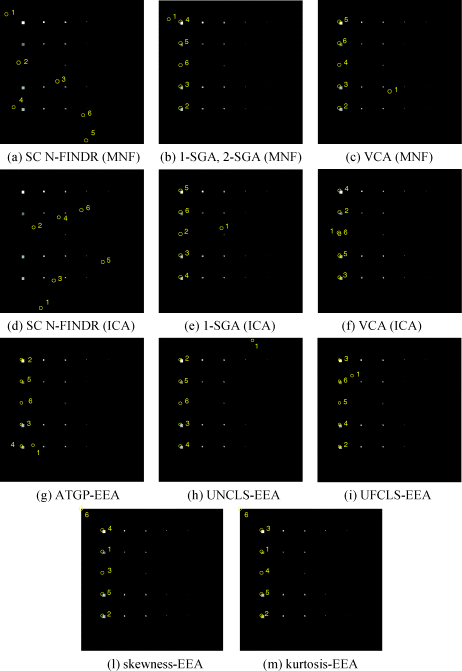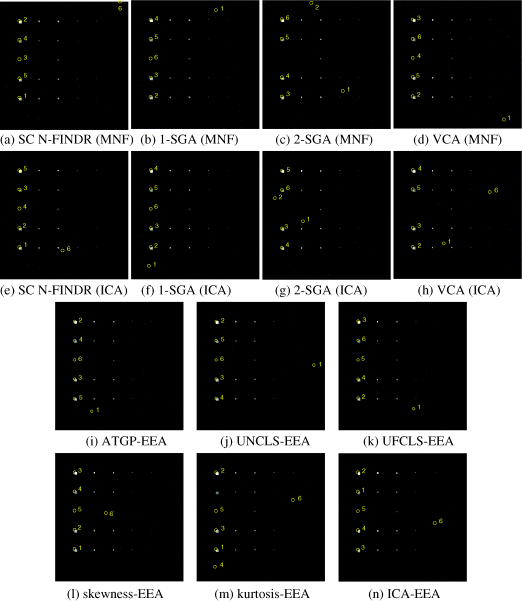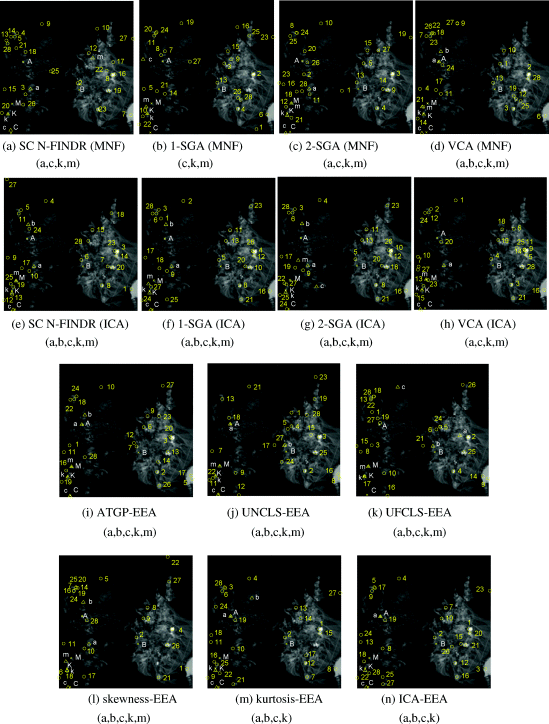8.7 Experiments
The experiments conducted in this section follow the same experiments conducted in Section 7.5 so that a comparative analysis on performance evaluation between SM-EEAs in Chapter 7 and SQ-EEAs in this chapter can be performed by comparing their respective experimental results, where the same six synthetic image-based scenarios, Cuprite image and HYDICE image are used for experiments. Four categories of SQ-EEAs are selected for performance evaluation, (1) OP-based EEA, VCA, (2) simplex-based EEA, SGA, SC N-FINDR, (3) second-order statistics least-squares error-based EEAs, ATGP-EEA, UNCLS-EEA, UFCLS-EEA, and (4) high-order statistics-based EEAs, HOS-EEAs (skewness-EEA, kurtosis-EEA), ICA-EEA. So, a total of nine SQ-EEAs, VCA, SC N-FINDR, SGA, ATGP-EEA, UNCLS-EEA, UFCLS-EEA, skewness-EEA, kurtosis-EEA, and ICA-EEA are actually studied in this section for comparative analysis. Several comments on the selection of these eight SQ-EEAs are worth noting.
8.7.1 Synthetic Image Experiments
The same six scenarios, TI1, TI2, and TI3 for target implantation (TI) and TE1, TE2, and TE3 for target embeddedness (TE) studied in Section 7.5 were also used for experiments to conduct comparative studies where eight SQ-EEAs, SC N-FINDR, 1-SGA/2-SGA, VCA, ATGP-EEA, UFCLS-EEA, UNCLS-EEA, skewness-EEA, and kurtosis-EEA, were evaluated for performance analysis. For the three SQ-EEAs, SC N-FINDR, SGA, and VCA, MNF and ICA were used to perform DR because MNF is more effective than PCA, in general, in terms of second-order statistics and ICA is the most widely used HOS-based DR transform. It is also noted that SC N-FINDR was used as an SQ N-FINDR due to its simple implementation. Since the number of endmembers to be extracted for six scenarios was estimated to be either p = 5 or 6, the dimensionality to be retained after DR was set to q = 6. Furthermore, since SQ-EEAs extracted endmembers one after another in a sequential order, numerals were used to indicate the orders that the pixels were extracted as endmembers and the endmembers extracted by SQ-EEAs using p = 5 were part of endmembers extracted by SQ-EEAs using p = 6 by setting q = 6. Figures 8.2–8.7 show that with six endmembers extracted by SC N-FINDR, 1-SGA/2-SGA, VCA, ATGP-EEA, UFCLS-EEA, UNCLS-EEA, skewness-EEA, and kurtosis-EEA using one set of random initial endmembers.
Figure 8.2 Results for scenario TI1 with six endmembers extracted by SC N-FINDR, 1-SGA, 2-SGA, VCA, ATGP-EEA, UFCLS-EEA, UNCLS-EEA, skewness-EEA, and kurtosis-EEA using one set of random initial endmembers.

Figure 8.3 Results for scenario TI2 with six endmembers extracted by SC N-FINDR, 1-SGA, 2-SGA, VCA, ATGP-EEA, UFCLS-EEA, UNCLS-EEA, skewness-EEA, kurtosis-EEA, and ICA-EEA using one set of random initial endmembers.

Figure 8.4 Results for scenario TI3 with six endmembers extracted by SC N-FINDR, 1-SGA, 2-SGA, VCA, ATGP-EEA, UFCLS-EEA, UNCLS-EEA, skewness-EEA, kurtosis-EEA, and ICA-EEA using one set of random initial endmembers.

Figure 8.5 Results for scenario TE1 with six endmembers extracted by SC N-FINDR, 1-SGA, VCA, ATGP-EEA, UFCLS-EEA, UNCLS-EEA, skewness-EEA, and kurtosis-EEA using one set of random initial endmembers.

Figure 8.6 Results for scenario TE2 with six endmembers extracted by SC N-FINDR, 1-SGA, 2-SGA, VCA, ATGP-EEA, UFCLS-EEA, UNCLS-EEA, skewness-EEA, kurtosis-EEA, and ICA-EEA using one set of random initial endmembers.

Figure 8.7 Results for scenario TE3 with six endmembers extracted by SC N-FINDR, 1-SGA, 2-SGA, VCA, ATGP-EEA, UFCLS-EEA, UNCLS-EEA, skewness-EEA, kurtosis-EEA, and ICA-EEA using one set of random initial endmembers.

Among six scenarios is TI2, which represents the most realistic one for endmember extraction because pure pixels are inserted into the noisy image background. In this particular scenario, all the eight SQ-EEAs except 2-SGA were able to extract five endmembers if p = 6. However, when p = 5, only HOS-based EEAs and those SQ-EEAs using ICA except 1-SGA to perform DR could extract all five endmembers in the first five pixels. This implies that HOS characterizes endmembers more effectively than second-order statistics. The same conclusions could also be drawn for TI1, TI3, TE2, and TE3. An interesting observation is scenarios of TI1 and TE1 where no noise is present in the image. In this case, all pixels, including background pixels, are clean and considered to be pure. As a result, SC N-FINDR had difficulty with determining which one was really a pure signature as an endmember. As a matter of fact, all SQ-EEAs using maximal simplex or convex hull volume as a criterion such as SGA or VCA had the same problem compared to other criteria, which did not have such a difficulty with finding endmembers as target of interest.
8.7.2 Real Hyperspectral Image Experiments
The same two real hyperspectral image data sets, Cupritre data in Figures 1.12(a) and (b) and the HYDICE image scene in Figures 1.15(a) and (b), were also used for experiments here.
8.7.2.1 Cuprite Data
The value of p estimated by VD for the reflectance data of the Cuprite scene in Figures 1.12(a) and (b) is 22, which has been used in Chapter 7 to evaluate SM-EEAs. However, based on SSE its estimate is 28. Since SQ-EEAs generate endmembers sequentially, in this case we use a large value of p to generate endmembers so that the first smaller number of endmembers would be those generated by a smaller value of p. Figure 8.8 shows nSSE = 28 (nVD = 22) endmembers extracted by eight SQ-EEAs, including two veriosns of SGA, 1-SGA and 2-SGA, where endmember pixels extracted by algorithms are marked by yellow circles, the pixels marked by upper cases of “A, B, C, K, M” are the five ground truth mineral pixels, and the pixels marked by yellow triangles with lower cases of “a, b, c, k, m” are identified by SQ-EEAs corresponding to the five true mineral signatures and are listed in the parenthesis underneath each figure.
Figure 8.8 Results for cuprite reflectance with nSSE = 28 (nVD = 22) endmember extracted by SC N-FINDR, 1-SGA, 2-SGA, VCA, UFCLS-EEA, ATGP-EEA, skewness-EEA, kurtosis-EEA, and ICA-EEA using one set of random initial endmembers.

Comparing the results in Figure 8.8 extracted by SQ-EEAs with those in Figure 7.25 extarcted by SM-EEAs, we find that the results were similar and close if an SQ-EEA was modified from its SM-EEA counterpart such as SC N-FINDR. As expected, using HOS-based SQ-EEAs or ICAs to perform DR did improve the performance of endmember extarction. Interestingly, ATGP- and LSE-based SQ-EEAs were shown to perform better than convex geometry-based SQ-EEAs.
8.7.2.2 HYDICE Data
Following the same experiment as conducted for the cuprite data, Figure 8.9 shows 10 endmembers extracted by eight SQ-EEAs including two versions of SGA, 1-SGA and 2-SGA, where the value of p was chosen to be a larger vaule of nSSE = 10 and nVD = 9. In the figure, the endmember pixels extracted by algorithms are marked by yellow circles and the pixels marked by yellow triangles are identified by SQ-EEAs corresponding to the five panel signatures and listed in the parenthesis underneath each figure.
Figure 8.9 Results for the HYDICE scene with nSSE = 10 (nVD = 9) endmember extracted by SC N-FINDR, 1-SGA, 2-SGA, VCA, UFCLS-EEA, ATGP-EEA, skewness-EEA, kurtosis-EEA, and ICA-EEA using one set of random initial endmembers.

Comparing Figure 8.9 with Figure 7.27, we observe that SQ-EEAs performed at least equally as SM-EEAs, including their counterpart, N-FINDR, and FCLS-EEA. Also, analogous to the Cuprite experiments, using HOS-based SQ-EEAs or ICAs to perform DR did improve the performance of endmember extarction.
